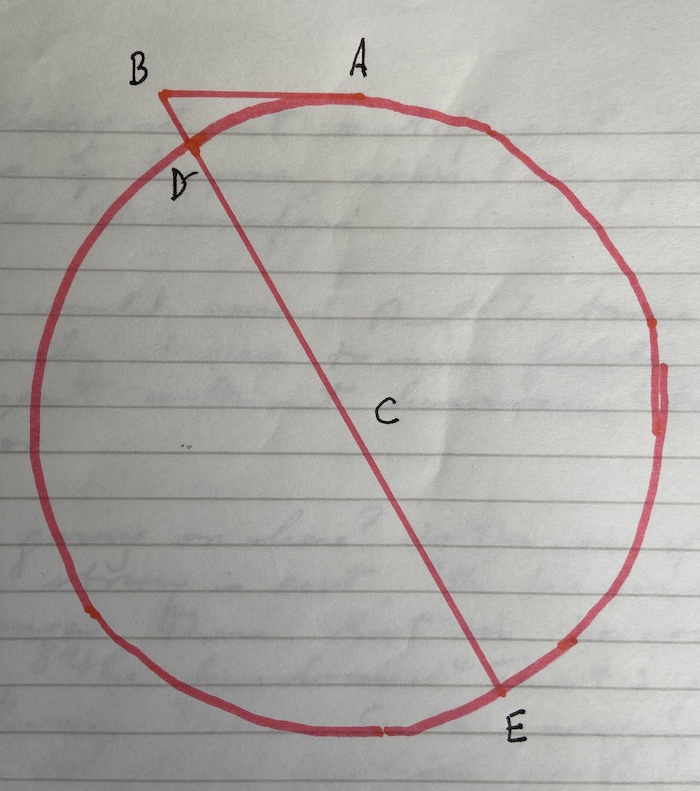OFER GAL - INVERSE SQUARE LAW
- Ofer Gal, Inverse square law. There is a paragraph where he claims that Newton "proves inverse square law from Kepler's third law." But what does Newton really do?
- Page 6. We are talking about Newton's manuscript from 1666.
- In this manuscript Newton proves the inverse square law from Kepler's third law, the harmonic law. With the help of the following simple diagram:

Şekil 1: Copy of Newton's figure (1666)
and a few bold mathematical moves, he proves that for a body revolving in a uniform motion, the 'conatus from center' (already labeled by Huygens 'vis centrifuga') is proportional to the radius of the circle divided by the square of its period of revolution.
- I shall not have time to attend to the diagram and proofs in any details, so I would like to concentrate on Newton's uses of the proportion
- The first of these is in calculating the centrifugal force (and the corresponding gravity) on the earth's equator and at the moon's orbit.
- After accomplishing this Newton applies his findings to regular and conic pendulums.
- But before doing this he adds the following as a rather marginal remark at the end of his corrolary:
Finally since in the primary planets the cubes of their distances from the sun are as the squares of the numbers of revolutions in a given time: the endeavors of receding from the sun will be reciprocally as the squares of the distances from the sun. (Herivel; p.197)
- This is not a difficult derivation:
if
\begin{equation*} f \propto \frac{R}{T^2} \end{equation*}and
\begin{equation*} T^2 \propto R^3 \end{equation*}then
\begin{equation*} f \propto \frac{R}{R^3} \end{equation*}or
\begin{equation*} f \propto \frac{1}{R^2} \end{equation*}namely: the "conatus a sole recedendi" is inversely proportional to the square of the distance from the sun.
- What is he talking about here: Unless enchanted by the very pronouncement of an inverse square ratio between distance and force, one cannot fail to notice the provisional, conditional status of inverse square law in [Newwton's manuscript On Circular Motion; it is true to the degree that Kepler's third law is correct.
- There is no question about Kepler's Rule, it is correct. So what is he talking about?
- Now section D, where he talks about Newton's De Motu
- In De Motu, that paper sent to Halley in 1684, Newton proves [what does prove mean in this context?] the inverse square law [why is this a law?] twice, in two different ways.
- The first is rather similar to tha proof in On Circular Motion, and I will not dwell on it.
- Immediately following this proof, however, Newton adds five corrolaries, all simple derivations from
where $\text{AD} is an infinitesimal arc.
- Since the motion is uniform, $\text{AD} is proportional to the body's velocity.
- And combining
with
\begin{equation*} f \propto \frac{\text{AD}^2}{R} \end{equation*}it follows that
\begin{equation} f \propto \frac{\text{V}^2}{R} \end{equation}Since the velocity is inversely proportional to the period, namely,
\begin{equation} \text{V} \propto \frac{1}{T} \end{equation}this is equivalent to,
\begin{equation} f \propto \frac{R}{T^2} \end{equation}This is basis enough to find a force law –a ratio between force and distance– for any given ratio between the radius of an orbit and the period of revolution, and Newton indeed offers three different force laws:
If,
\begin{equation} T^2 \propto R \end{equation}then, \(f\) is distance-independent.
If,
\begin{equation} T^2 \propto R^2 \end{equation}then, \(f \propto 1/R\)
and
\begin{equation} T^2 \propto R^3 \end{equation}then, \(f \propto 1/R^2\)
- Page 10. I think we are still talking about De Motu
- And in the following Theorama IV this particular force law, endowed with its new significance, is used to derive Kepler's third law:
Supposing that the centripetal force is inversely proportional to the square of the distance from the center, the squares of the periodic times are as the cubes of the transverse axes.
- [What is Newton's contribution here to Kepler's Rule?]
- The direction of this last theorem is opposite to that of Theorema II; inverse square law is now assumed, and it is used to prove the harmoniç proportion between distances and periods